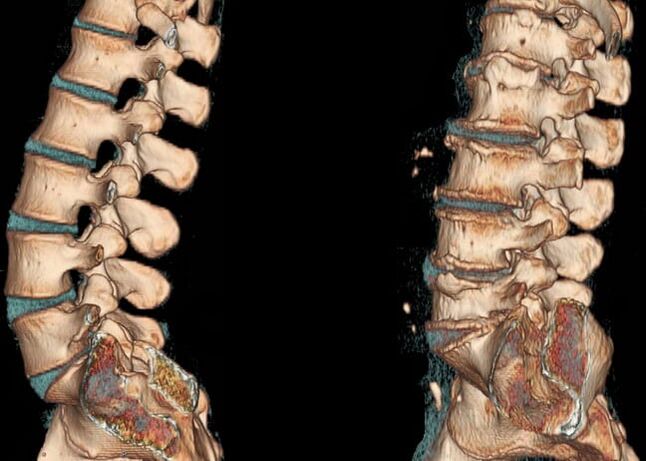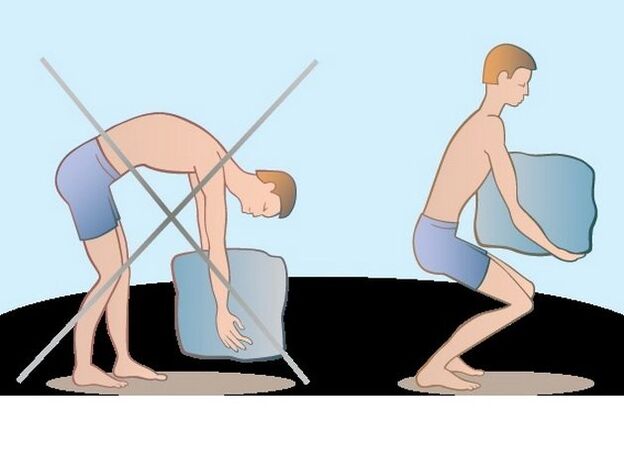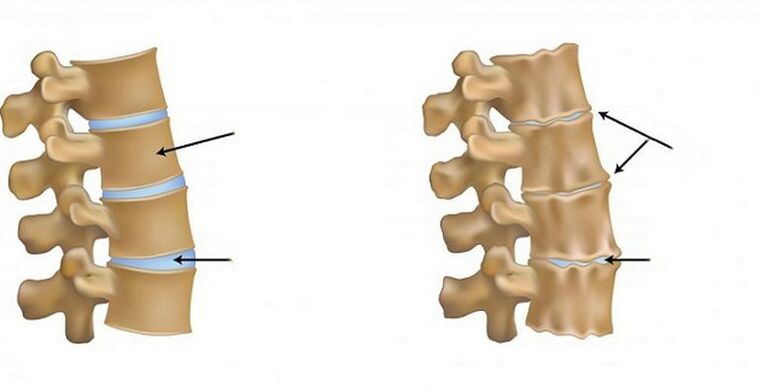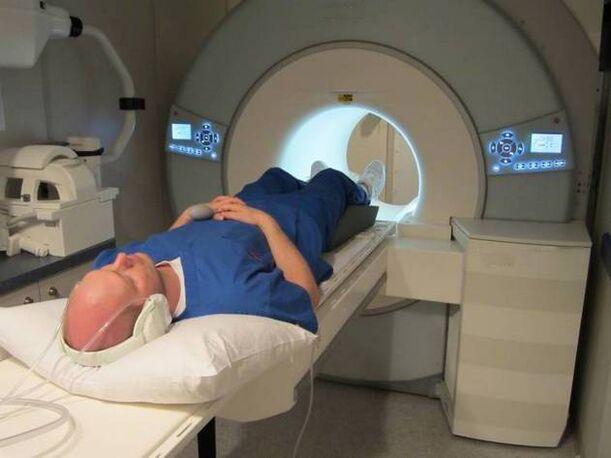
People with osteochondrosis of the lumbar spine always avoid sudden movements, carefully lean and turn to the sides, slowly sit down, get up.So they try to prevent sharp, piercing lower back pain, forcing them to freeze in one position of the body.Osteochondrosis is also manifested by crunch, clicks, limitation of mobility.Its treatment is more often conservative, but with severe damage to the discs and vertebrae, surgical intervention is required.
What is osteochondrosis of the lumbar spine
Lumbar osteochondrosis is a degenerative-dystrophic pathology, which initially affects intervertebral discs.Due to the insufficient intake of nutrients, they lose the ability to retain moisture.Regeneration processes slow down, discs become flat, fragile.The distance between adjacent vertebrae is reduced, therefore, bone tissues grow to stabilize the lumbar segment affected by osteochondrosis.Osteophytes are formed - bone growths, with the displacement of which soft tissue structures, nerve roots, blood vessels are injured.
Stages of pathology
The stage of osteochondrosis is the stage of development of the disease, which is characterized by certain destructive changes in the disks and bodies of the vertebrae.It is established using an X -ray examination.On the resulting images, specific signs of destruction of vertebral structures are clearly visible.Each stage corresponds to the severity of osteochondrosis, a set of symptoms.The higher it is, the more difficult the disease lends itself to conservative treatment.
| Stage of lumbar osteochondrosis | X -ray features and clinical manifestations |
| First (preclinic) | There are no signs of osteochondrosis on radiographs.Occasionally there are uncomfortable sensations in the lower back after physical exertion or long -term stay on the legs |
| The second | There is a rectification of lordosis, less often - the scenes of the vertebral bodies, the deformation of semi -moon processes.The height of the discs is slightly reduced.Painful sensations appear more often, their duration increases |
| The third | Subchondral sclerosis of the closing plates, damage to a large number of semi -moon processes, and a moderate decrease in the height of the disk are observed.In addition to pain in the lumbar region, the clinic contains a crunch, stiffness of movements |
| Fourth | Semi -moon processes are rejected outward and posteriorly.There is a compensatory growth of bone tissues, the formation of multiple osteophytes.Pain occurs when moving and at rest |
Causes of the disease

The causes of the development of osteochondrosis are often increased loads on the lumbar spine.The discs are constantly microtrauma, not having time to recover in a timely manner.A significant part is gradually damaged, launching the deformation of bone bodies of the vertebrae.Such pathological conditions are also capable of provoking the destruction of the lumbar segment:
- congenital or acquired anomalies - flat feet, scoliosis, kyphosis, valgus deformation of the foot, TBS dysplasia;
- systemic pathologies - rheumatoid arthritis, scleroderma, red lupus;
- endocrine and metabolic diseases- gout, diabetes mellitus, hypo- and hyperthyroidism, obesity;
- previous injuries - subluxation of the vertebrae and their fractures, damage to the spinal cord;
- circulatory disorders, including against the background of a sedentary lifestyle.
One of the main causes of osteochondrosis is the natural aging of the body.After 50 years, recovery processes slow down, collagen production decreases, the state of the ligaments worsens.
Characteristic signs and symptoms of the disease
At the initial stage of development, osteochondrosis does not appear clinically.A person takes weak soreness of the lower back for muscle overvoltage after a working day and does not consult a doctor.But the severity of the symptoms is slowly increasing - soon a crunch with tilts and turns of the case, sensitivity disorders, and stiffness are joined in pain.
Rook syndrome
This is the name of the defeat of the spinal roots, which leads to motor, vegetative and severe disorders.Rotor syndrome develops with osteochondrosis of 3-4 severity.At these stages, an intervertebral hernia is formed, compressing the spinal roots.Pathology proceeds according to the type of lumbago, lumbalgia and lumbar -ilgia.In addition to severe pain, the radicular syndrome is characterized by sensations of numbness, tingling, crawling goosebumps, decreased or complete absence of sensitivity.
Ischemic syndrome

In the late stages of the course of lumbar osteochondrosis, it is possible to compress herniacating large blood vessels.The pelvic organs cease to receive a sufficient amount of nutrients, which leads to a violation of their functioning.The cerebral cerebral trophy is also upset, a neurological deficiency develops - an intermittent lameness appears, temperature, pain sensitivity falls.
Vertebrate syndrome
As a result of reducing the distance between the adjacent bodies of the vertebrae, the growth of bone tissues, the lumbar vertebral segments are gradually deformed.The situation is aggravated by constant compensatory stress of the back muscles with their subsequent atrophy.Pathologically changes the gait and posture of a person, including due to improper redistribution of loads.The likelihood of involving other parts of the spine and joints of the legs in the destructive-depressive process is significantly increased.
Pain syndrome
In the bottom of the back is a large sciatic nerve formed by sacral spinal roots.When it is infringed on with hernial protrusion, bone growths, spasmodic muscles, Ishias occurs - a typical symptom of lumbar osteochondrosis.There is an acute pain spreading along the sciatic nerve to the hips, knees, lower legs (lumbar -ilgia).Another specific feature of the pathology - lumbago, or “shots” in the lower back after a sharp inclination or turn, hypothermia.
Diagnostic methods

When making a diagnosis, radiographic pictures taken in two projections are most informative.To study in more detail the affected lumbar segment, an MRI is performed.The study allows you to evaluate the condition of the spinal cord, soft tissue structures, blood vessels, nerve roots.It is possible to determine the degree of damage to the nerve trunks using the caused potentials, electronography, electromyography.For aiming examination of the affected discs, discography is used.
How treatment is carried out
A comprehensive approach to therapy for lumbar osteochondrosis is practiced.The treatment is aimed at eliminating pain, restoring the volume of movements, preventing the spread of pathology to healthy discs and vertebrae.
Drugs
The use of non -steroidal anti -inflammatory drugs, glucocorticosteroids, muscle relaxants allows you to get rid of lower back pain.In therapy, drugs are used to improve blood circulation.Patients must be prescribed vitamins of group B, chondroprotectors.
Medical physical education
This is the most effective and affordable treatment for osteochondrosis.After 1-2 months of daily treatment of physiotherapy exercises, the muscles of not only the lower back, but the whole back, improves posture, accelerate the blood supply to damaged connective tissue structures.LFK doctors recommend that patients recommend slow smooth turns and torso tilts, shallow squats and lunges.
Massage
Patients with lumbar osteochondrosis show all types of massage - vacuum, acupunctural, connective, segmental.But the most in demand is classic.During the session, the massage therapist performs the main massage movements: stroking, rubbing, kneading, vibration.The goals of the procedures are to eliminate muscle cramps, improve blood circulation in the affected segment, and strengthen skeletal muscles.
Physiotherapy
In an acute and subacute period, patients are prescribed by electrophoresis or ultrafonophoresis with glucocorticosteroids, anesthetics, group B vitamins. At the remission stage, laser therapy, magnetotherapy, stressed-wave therapy, and UHF therapy are often carried out.Ozokeritoling, paraffin applications, hirudotherapy, mud, radon, hydrogen sulfide baths are also used.
Surgical intervention
The main indication for surgical intervention is the infringement of the spinal cord with hernial protrusion.During the operation, the intervertebral hernia is removed, decompression of the spinal canal is carried out.The most frequently used methods of surgical intervention for lumbar osteochondrosis are microdiscectomy, puncture vaporization or laser reconstruction of the disk, implant installation, stabilization of the vertebral segment.
Traditional medicine
After the main therapy, the achievements of stable remission in the treatment, home -made ointment, herbal teas, compresses, oil and alcohol rubbing are used.Folk remedies do not affect the cause of osteochondrosis, therefore they are used to eliminate weak, aching pain, severity in the lower back after hypothermia, a sharp change in weather or increased physical activity.
The consequences of the lack of treatment
The development of almost all complications of lumbar osteochondrosis is provoked by the formed intervertebral hernia.Discogenic myelopathy is especially dangerous, which does not always turn out even surgical treatment.It is manifested by pelvic disorders, including disorders of defecation, urination.The complications of osteochondrosis also include rooser syndrome - a common cause of acute, piercing lower back pain.
Prevention and forecast measures
The prognosis is favorable in the diagnosis of pathology of 1-2 degrees of severity.It lends itself well to conservative treatment, and in young patients it is even possible to partially restore tissues of intervertebral discs.With the development of complications, the forecast for full recovery is less favorable.
Prevention of osteochondrosis of the lumbar spine is to control body weight, exclusion of excess loads, timely treatment of endocrine, metabolic diseases.Neurologists and vertebrologists recommend visiting the swimming pool, engage in aquaerobics, Pilates, Scandinavian walking.



















